Bamboo is not really wood, you know. Bamboo plants are a kind of tree-like grass, resilient, fast-growing, and quite remarkable for their many uses.
They are some of the most useful plants on Earth, not least because of their amazing potential as a source material across industries. But they are also beautiful in themselves.
In this article, we will explain the process behind growing bamboo plants, how to care for them, and where you can find them for sale. Let’s start with the different bamboo varieties.
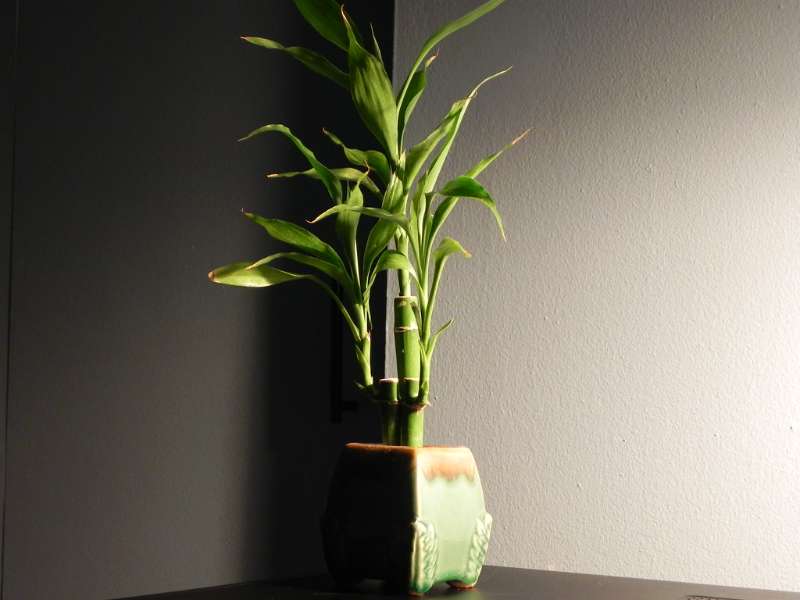
Bamboo Plant Varieties
Bamboo comes in many shapes and sizes: Chinese, Japanese, artificial, and the so-called ‘Lucky-Bamboo’ plant. They also come in outdoor and indoor varieties.
But, broadly speaking, there are two main types of bamboo: the running kind, and the clumping kind.
The running kind of bamboo is an aggressive and invasive plant that generally grows in temperate climates. As you may guess from its name, this type of bamboo tends to grow and spread very quickly.
The clumping kind of bamboo, on the other hand, normally grows in tropical climates. It tends to clump together. It’s this type that we use across the world to make furniture, houses, and, in Asia, almost everything you can imagine.

For growing bamboo plants inside your home, you’ll generally want to stick with the clumping kind.
Tip: Because of its growth speed and its strength, running bamboo can be difficult to grow inside without the right conditions. Still, it’s possible to enjoy the sight of these beauties in your living room or conservatory for several years.
If you have the space in your garden, it’s possible to grow different varieties of bamboo quite easily. Keep reading to discover some different types of running and clumping bamboo to find your favorites.
Running Bamboo Plants
First up is the “running bamboo”. Sometimes considered an aggressive pest, this type of bamboo generally grows and spreads the fastest. It has sometimes been known to take over entire forests!
Warning: Be careful when growing it in your home. It can take over entire back yards, growing out to the street and pushing up the sidewalk!
This bamboo does this because of the way it grows underground. Running bamboo grows vertical rhizomes which run horizontally underneath the plant. This enables it to spread very quickly.
Because of this, it can be harvested en masse, but it’s not necessarily the best for your nice tidy garden.
Golden Groove Bamboo (Phyllostachys Aureosulcata)
The well known (sometimes called yellow) golden groove bamboo is evergreen, meaning it can be grown at any time of the year. It gets its name from small golden grooves that appear on either side of the cane.

It always seems to grow straight up, meaning that it’s ideal for pots or otherwise for creating a hedge. In the Zhejiang province of China, this plant is used for ornamental purposes.
This species of bamboo has been known to grow 3-5 feet every year. Also, remember that it is a “running bamboo” and can spread aggressively.
Kuma Bamboo (Sasa Veitchii)
This one might not look like traditional bamboo, but it’s actually a variation called Kuma Bamboo.
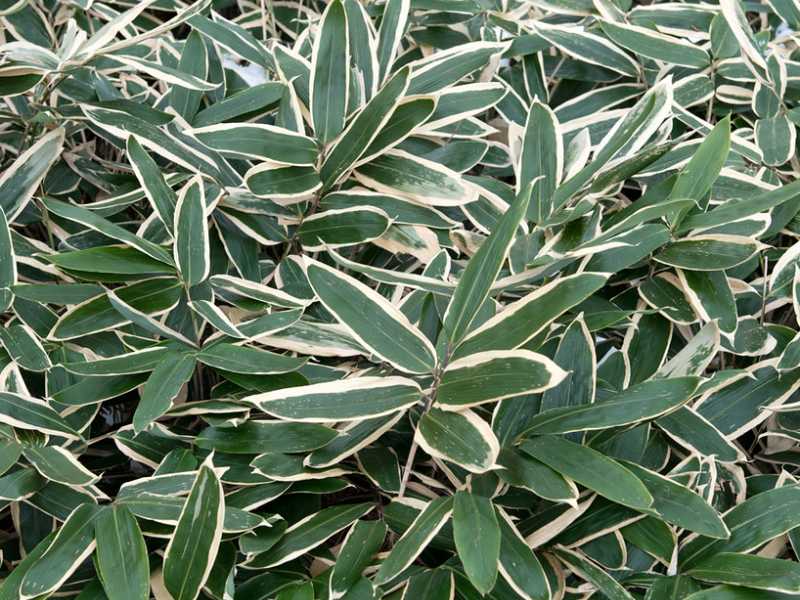
This type is known as “dwarf-bamboo'” growing only to a height of 5 feet because it grows so low to the ground. Because of this, the Kuma Bamboo can be quite useful if you want to make a low hedge.
It’s a great outdoor plant with beautiful foliage in winter, but remember to keep this one under control if you plant it in your garden!
Red Margin (Phyllostachys Rubromarginata)
Red margin, on the other hand, is an excellent choice for creating a natural wall because of its height. This species of bamboo can grow as high as 60 feet!

It’s one of the fastest-growing bamboos, and the wood is of superb quality. It’s also very hardy in cold climates, so it doesn’t mind being brought over from China to your backyard!
Clumping Bamboo Plants
Next up is the running bamboo’s overly-friendly brother, the clumping bamboo!
Instead of growing in the characteristic “runs” of running bamboo, this type clumps together to form a thick, dense bamboo forest.
It doesn’t grow the horizontal rhizomes that we mentioned before, and this makes it a better choice for growing indoors, as well as less of a nuisance in your garden.
Hedge Bamboo (Bambusa Multiplex)
Bambusa Multiplex is essentially the father of all other types of hedge bamboo plants.

This particular species can grow up to 35 feet in height, and clumps together to form an impressive wall. You can use it to design a privacy wall or to create a grand looking entryway.
This plant is also very sun-resistant and hardy. It’s the best choice for a hedge as it can create a natural fence for your garden. This is a creative way to get yourself some privacy in a natural way.
Umbrella Bamboo (Fargesia Murielae)
Fargesia Murielae, or “umbrella bamboo”, was at one point considered the most beautiful type of bamboo in the world.
As you can see in the picture above, it can create cascades over pristine blue waters in its rainforest home!

Clumping together to form a massive, overhanging canopy, this species is certainly a sight to behold. The plant carries a subtle hint of light blue in the stems when young, and grows later in life to an aged yellow.
This plant thrives best when it gets some shade throughout the afternoon, and doesn’t need to be cordoned off to stop it from spreading. This makes it a great addition to your garden if you have space.
Giant Japanese Timber (Phyllostachys Bambusoides)
This versatile fellow, the Japanese timber, actually makes up around 60% of the bamboo harvested for various uses in Japan.
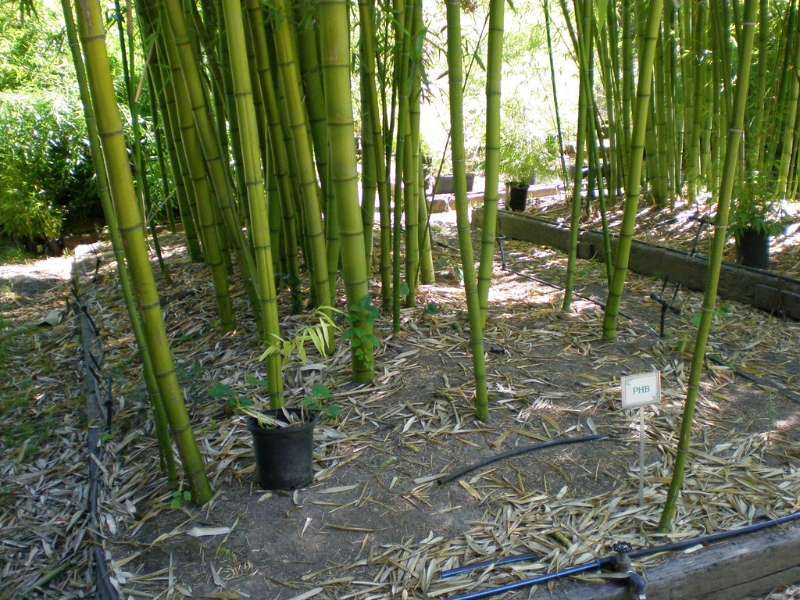
It’s the second-largest bamboo grown in temperate climates and is remarkable for its long, straight canes which make it perfect for construction.
But its uses don’t stop there. Besides construction, the Japanese timber is famous for its use in making traditional flutes in Japan, as well as digeridoos!
The Best Indoor Bamboo Plants
For your indoor plants, you’re probably going to want to go with the clumping kind of bamboo we mentioned earlier.
There are a few simple hints and tips that can help your indoor bamboo reach its full potential, but first, here are some examples of bamboo plants that can grow indoors.
Choose the one you like the most!
Large Leaved Bamboo (Indocalamus Tessellatus)
Mostly found in China, this little guy is, like the Golden Groove, another evergreen plant. This means that if you keep it indoors with plenty of shade and moist soil, it will retain its green hue all year round.

It’s a hardy plant and can survive in quite rough conditions for a long time, making it quite an easy bamboo plant to grow in your indoor garden.
Keep it in a large container, and eventually, it will start to form dense green thickets of bamboo.
Black Bamboo (Phyllostachys Nigra)
First brought west around 1827, this beautiful bamboo starts off with yellowy-green canes, but after two years of direct sunlight it takes on a mystical ebony persona.

These plants can spread quickly in the forest and can grow up to 30 feet. However, if you keep them in containers indoors, it will only grow to about a quarter of that.
Remember that without containment this plant, as running bamboo does, may spread quickly and become invasive.
Tip: Give it plenty of sunlight, and make sure the soil is consistently moist to give it the best chances of survival.
Lucky Bamboo (Dracaena Sanderiana)
Although marketed as “Lucky Bamboo”, this plant actually comes from the Asparagaceae family.
Considering it just grows in water, this makes our “Lucky Bamboo” more akin to a water-lily that the rest of our bamboo plants.
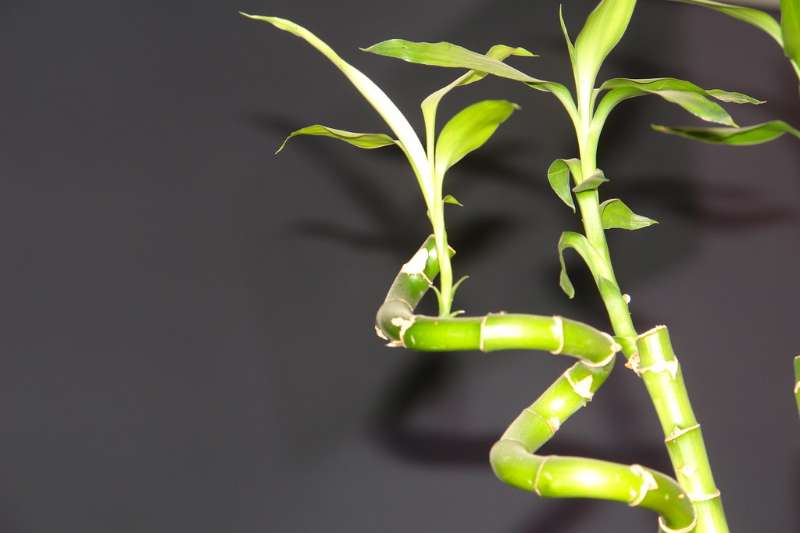
This plant should be placed in a small dish or glass vase with some small stones around the base.
Tip: Fill with water (try to use distilled or filtered) about 2 inches above the roots. Remember to change the water, and give it a bit of sunlight every day, and this plant could stay with you for 4 years or more!
“Lucky Bamboo”, believe it or not, is supposed to bring good luck to your home, and balance out the feng shui of normal everyday life. So keep it alive!
How to Grow Bamboos Plant Indoors
Once you’ve decided on which bamboo plant to grow, you need to know how to grow it. Not that bamboo is a very demanding plant. But you’re probably growing it outside of its natural habitat.
We’re well aware that many of you won’t have the excess garden space to grow entire bamboo forests (who does?!).

Because of that, we want to go into a bit of detail about how to grow your bamboo plants indoors. Below, we’ll first discuss the best indoor bamboo plants.
How to Grow a Bamboo Plant
Step 1 – Pot It Right

Place your bamboo plant in a pot of gravel and soil, and then put it in a tray of low water. This is a great way to raise the humidity levels of your plant.
Keep in mind that some varieties can grow directly in a vase with water. Those may not last indoors as long, though.
Step 2 – Avoid Overwatering

The most important thing to think about when growing indoor bamboo plants is water.
Because, indoors, they generally have less air circulation and light, it can be quite tempting to overwater them. Look for the tell-tale sign of browny-yellow leaf tips.
Step 3 – Mist It Now and Then
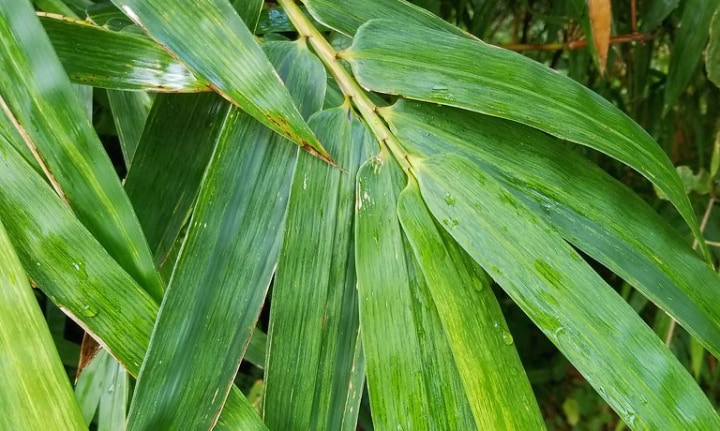
Humidity levels are also important. One thing you can do is to give the leaves of your bamboo an occasional misting.
Step 4 – Don’t Forget to Fertilize
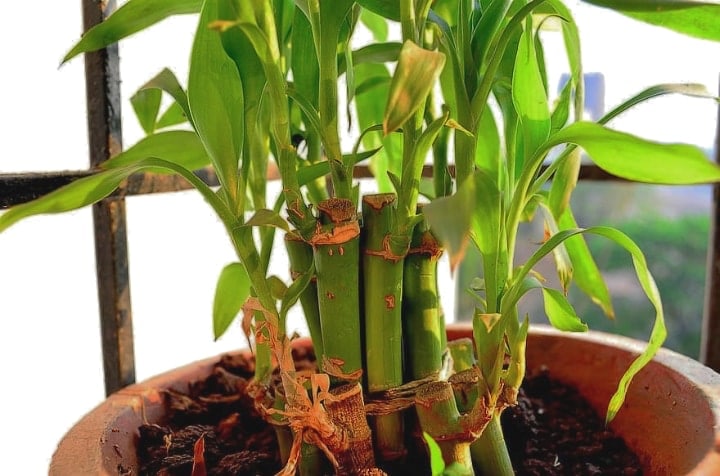
Fertilizer is also very important. If you start to see these dying yellow leaves on your bamboo, it might be an idea to add some fertilizer to your plant to give it a new lease for life.
Step 5 – Move It Outside If Needed

Remember that bamboo plants are really meant to be outside, so they can struggle a bit when you first put them inside.
If the plant seems to be losing leaves or dying when it first comes inside, try giving it some months outside. You’ll be surprised how much difference this can make to its growth.
Bamboo Plant Care
Bamboo is a relatively simple plant to grow, whether that’s indoor or outdoor. However, there are as always some important things to bear in mind when caring for your bamboo plants.
Watering
When you first plant your bamboo, you need to water it regularly. Twice a week when normal weather, but maybe five times a week during hot/windy weather.
This is until the bamboo plants reach a larger size, at which point they can survive with a lot less water. The same goes for flooding/overwatering.
Newly planted bamboos are extremely sensitive to this, but once they have reached maturity, they are much more hardy.

It’s still very important to remember not to overwater your plant. When this happens, you’ll see that the leaves will begin to turn yellow-brown and droopy, in this case, hold back on the water.
Soil
A few things you can do to your soil to give your bamboo plants the best chance of growing well are: make sure the soil is loamy and a bit acidic.
Tip: Use compost or manure around the base of the bamboo’s roots to fertilize and improve drainage, or just mulch the soil heavily.

Still, remember not to use too much fertilizer, as this can be just as bad (or worse!) as no fertilizer.
A good natural way to keep the ground around the bamboo fertile is to avoid sweeping up fallen leaves. These actually keep the soil soft and moist and create the ideal grow-bed for bamboo.
Sunlight
The amount of sunlight to give your bamboo varies between different species, shapes, and sizes.
Larger bamboos (Phyllostachys), for instance, can do with about 5 hours of direct sunlight every day.
However, when these are new plants, its best to give them a lot of shade throughout the day. Same goes for smaller varieties of bamboo.

Thamnocalamus and Fargesia, for instance, even when mature, are happier with spending the best part of their day in the shade.
Propagating Your Bamboo Plant
Bamboo plants are grown from rhizomes, growths underneath the soil that form buds and culms.
Propagating basically involves clipping the rhizome from the parent plant and replanting it before it begins to grow.
The process differs for running and clumping bamboo because remember that they grow differently.
Running Bamboo Plants
To propagate the running variety of bamboo, wait until spring and dig around the soil to see if there are new buds and rhizomes.
The rhizomes are horizontal, with new buds growing on the dividing sections of the bamboo, on which new hollow stems will sprout.
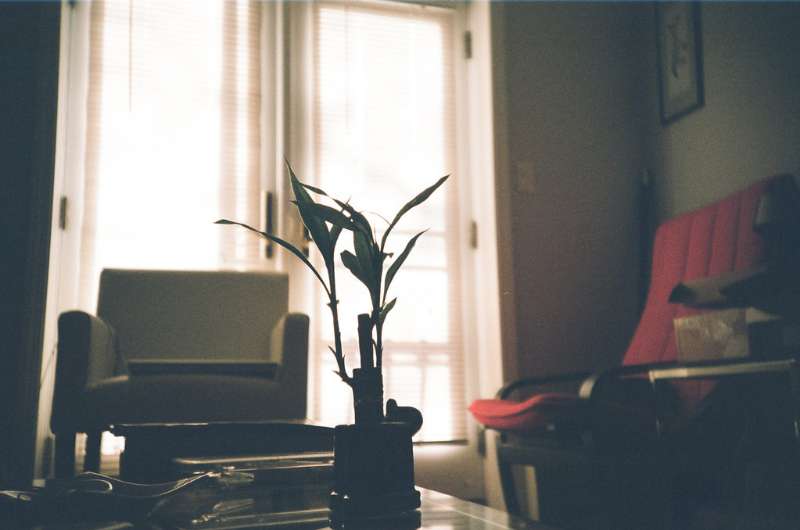
Cut out a section which has buds and culms, but no new growth. Place the taken rhizome in soil. Water and mulch thoroughly.
Important: Make sure the parent plant has plenty of water and soil around the base.
Clumping Bamboo Plants
For the clumping variety, the process is pretty much the same. The only difference is that you are looking for a clump, one with about four culms and rhizomes with buds, and cutting that away from the plant.
Pull up this clumping part of the bamboo, and place it in soil. The rest of the process is the same as for running bamboo.
Bamboo Trees and Plants for Sale
When it comes to buying bamboo plants, we’ve picked two of what we consider the best providers.

For seeds, plants, and decorations for housing your bamboo plants, we recommend Etsy. You can find there a wide range of plants and ornaments for making your house a home.
We can also recommend checking out the huge selection of bamboo plants on Amazon, which provides an eclectic mix of different types of bamboos for both your house and garden.
Here are some of the bestselling bamboo plants on Amazon right now.
Bamboo Plants Frequently Asked Questions
He heard a lot of questions about bamboo plants recently and though we may as well gather them here and answer them. We hope you find the answers useful!
How do I take care of a bamboo plant?
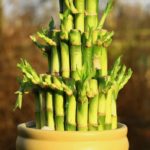
The key things to remember is to water bamboo plants sparingly unless the weather is very hot and to always make sure that the soil is neither too moist nor too dry. Using too much soil or too much fertilizer can actually harm your bamboo.
Can bamboo grow in pots?

Yes, you can grow most species of bamboo in pots. However, with some species that can be more complicated than with others. As a rule of thumb, running bamboo is generally more difficult to grow in pots than clumping bamboo.
How long does bamboo take to grow?
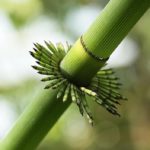
It varies between different species of bamboo, but your average bamboo plant normally takes about three years to reach maturity.
Where should we keep bamboo at home?

Ideally, you should keep your bamboo plant out of direct sunlight. The east corner of the house is a good place to keep your bamboo plant to achieve this.
Bamboo Plants Aren’t Bamboozling
Not at all pretentious, bamboo plants are good house plants and less complicated than orchids, chrysanthemums, or other flowers.
They give the feeling of being in the rainforest; in the far-east, surrounded by temples and waterfalls. Who wouldn’t want to bring this feeling to their house?
Bamboo comes in many shapes and sizes, but the running and clumping types are the two main types you need to know.
These both have their own uses, but remember, for your purposes, you will mostly want to stick to the clumping kind.

Your greatest challenge is likely going to be choosing from the huge variety of beautiful plants that are on offer. But we hope this article has been of some help with that!
Next time you’re shopping online, or driving past your local garden center, maybe you’ll consider picking up a lucky bamboo plant to spice up your bedroom.
Have you ever grow bamboo plants before? Use the comments section below now to let us know.
See you next post!

I have my Dracaena Surculosa for 17 years and still bloom and alive.
I have a Gold Dust Dracaena. Ok, So I got one of these in a flower arrangement in 2000 when my mom passed away, had it for a while, and it didn’t grow much, a cat got into it and peed in it, which, I thought at the time killed it, this had to be around 2009-2010. I got lazy and just left the pot alone. But in 2012 my father passed away and I got a peace lily and set it next to the Gold Dust Dracaena, and not long after that in started growing again. Now it is the year 2020 and it has grown to be about 6 feet in height. it blooms twice a year and it produced an orange pod in early 2019, and it is still on there, I just noticed about a month ago 2 more pods. Would you happen to know anything about these orange pods? Are they seed pods or something else?
Dear Shannon! Thank you for leaving such a heartwarming comment on our post, and what a beautiful story of plants starting growing like that after something significant happened to the owner. This is not the first time I hear a similar story like yours! As for the orange pods, the roots of a bamboo plant are generally bright white or orange when they are healthy and strong. Normally if a bamboo plant would be infected the leaves are yellow or have yellow spots on them or the roots are brown, black, or grayish. I hope this helps, and for further examination, I would need to see a picture first. You can always reach out to us directly via the contact form here. Much love, nancy